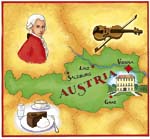City Break: Vienna
It’s a wonderful year to visit Vienna, which is celebrating the 150th birthday of its most famous artist, Gustav Klimt


What I did - The Kunsthistoriches Museum (www.khm.at) has Thursday gourmet evenings when you can wander between courses through galleries crammed with Old Masters from the imperial collections. A temporary platform allows close scrutiny of Klimt's murals around the staircase, done with his brother Ernst and Franz Matsch-see also their work in the Burgtheater (www.burgtheater.at).
Finding fin-de-siècle Vienna - J. M. Olbrich's glittering Secession Building (www.secession.at) is an icon of Viennese Art Nouveau or Jugendstil. Conceived as a Temple of the Arts, this proto-Modernist hall showcased works by the Viennese Secession, the group founded in 1897 as a protest against Künstlerhaus historicism. Surviving here is Klimt's radical Beethoven frieze from the 1902 exhibition that promoted the concept of Gesamtkunstwerk-the unification of Arts, architecture, poetry and painting-that so revitalised the city. The Museum of Applied Arts (MAK) (www.mak.at) contains highlights of the Wiener Werkstätte, the 1903 alliance founded as an urban Arts-and-Crafts initiative. Slick examples of recent design feature in the shop and restaurant named after its chef, Helmut Österreicher.
My hotel - Das Tyrol, an arty little boutique hotel excellently located on the edge of the Museums Quarter. Best thing about it: the breakfasts. Rooms start at €109 (00 43 1 587 5415; www.dastyrol.com).
My favourite landmark - The Belvedere (www.belvedere.at), a pair of 18th-century palaces linked by French-style gardens overlooking the city. Baroque interiors are filled with highlights of the Royal Collection: paintings by Monet, van Gogh and Schiele, plus 22 of Klimt's works, including the crowd-pulling The Kiss.
Architectural revelations - Otto Wagner was born in the Biedermeier years in 1841 and died a Modernist in 1918-the same year as Klimt, Moser, Schiele and the Hapsburg Empire. I loved his revolutionary Post Savings Bank (www.ottowagner.com), which anticipates the Bauhaus by 20 years. A late masterpiece is in the pine-grove setting of the psychiatric hospital. Crowning the hill, the domed edifice of St Leopold am Steinhof (1905-07) still draws gasps of wonder (open Saturdays 4pm-5pm, Sundays 12-4pm). Other Wagner landmarks are his Stadtbahn buildings and apartments decorated with gilt and floral majolica overlooking the Naschmarkt.
How I indulged - Gastronomic pleasure is reason enough to visit Vienna, with its melting pot of traditions from the furthest reaches of the empire: spicy Hungarian goulashes, Bohemian dumplings (Knödel) and pan-cakes (Palatschinken) and Balkan sausages (Cevapcici). The Viennese favour the beisl, a sort of pub serving local specialities. The province is a major wine grower, best known for its white wines, drunk at the vineyard's own wine tavern or Heuriger. The Wien Wein group (www.wienwein.at) has revived the classic blended Wiener gemischter satz-Mayer am Pfarrplatz's is particularly drinkable.
What I bought - Rich chocolate Sachertorte, Apfelstrudel and my favourite almond-based Linzertorte from the ultimate Konditorie Demel, where you can watch the chefs work (www.demel.com); chocolates from Wiener Schokoladekönig, a former button shop with old-world fittings, and delicacies from Meinl am Graben, a sort of Austrian Fortnum & Masons.
Sign up for the Country Life Newsletter
Exquisite houses, the beauty of Nature, and how to get the most from your life, straight to your inbox.
Best for atmosphere - The coffee houses, where you can while away hours absorbing atmosphere and etiquette, playing bridge or reading the newspaper, are an institution. Each has its own style and clientele. I loved Café Sperl, the Secessionists' first meeting place and fin-de-siècle haunt of Mahler; bohemian Café Hawelka, with its maroon and wood-panelled walls, shabby banquettes and fresh Buchteln (dumplings filled with plum jam); and Café Prückel, with its Third Man feel, where you can even still smoke, although, oddly, only in the room where all the cakes are.
What's on in the year of Klimt's anniversary - The year-long programme of exhibitions dedicated to the work and circle of Klimt (www.klimt2012.info/en). Highlights include: ‘Gustav Klimt at the Kunsthistoriches Museum' (Until May 6, www.khm.at); ‘150 Years Gustav Klimt' in the Upper Belvedere (July 12-January 6, 2013, www.belvedere.at); ‘Klimt: The Wien Museum Collection' at the Wien Museum (May 16-September 16, www.wienmuseum.at); ‘Gustav Klimt: Up Close and Personal' at the Leo-pold Museum-the man behind the art, his travels and personal life, including a stream of letters to Emilie Flöge (until August 27, www.leopoldmuseum.org); ‘Gustav Klimt: Expectation and Fulfilment' at the Museum of Applied Arts (MAK), with the painstakingly restored working sketches for his ambitious Palais Stoclet Mosaic Frieze of 1910-11 (until July 15, www.mak.at); ‘Gustav Klimt: The Drawings' at the Albertina (until June 10, www.albertina.at).
to Country Life and save £40%
Country Life is unlike any other magazine: the only glossy weekly on the newsstand and the only magazine that has been guest-edited by HRH The King not once, but twice. It is a celebration of modern rural life and all its diverse joys and pleasures — that was first published in Queen Victoria's Diamond Jubilee year. Our eclectic mixture of witty and informative content — from the most up-to-date property news and commentary and a coveted glimpse inside some of the UK's best houses and gardens, to gardening, the arts and interior design, written by experts in their field — still cannot be found in print or online, anywhere else.
-
 About time: The fastest and slowest moving housing markets revealed
About time: The fastest and slowest moving housing markets revealedNew research by Zoopla has shown where it's easy to sell and where it will take quite a while to find a buyer.
By Annabel Dixon
-
 Betty is the first dog to scale all of Scotland’s hundreds of mountains and hills
Betty is the first dog to scale all of Scotland’s hundreds of mountains and hillsFewer than 100 people have ever completed Betty's ‘full house’ of Scottish summits — and she was fuelled by more than 800 hard boiled eggs.
By Annunciata Elwes